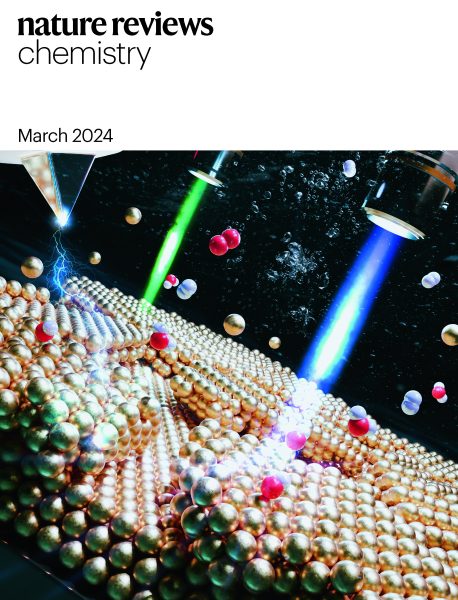Better Together: A Multiscale, Multitechnique Look at the Electrochemical Interface
Understanding electrochemical interfaces is vital for advancing energy conversion technologies. Innovative combinations of optoelectronic techniques and modeling now allow researchers to visualize and interpret the complex, evolving nature of these interfaces. This multiscale approach enables deeper mechanistic insight, accelerating the design of efficient, stable, and sustainable electrochemical systems.
Original publication: Complementary probes for the electrochemical interface.

Figure. Artistic visualization of the electrochemical interface as a dynamic frontier—explored through the integration of optoelectronic, mechanical, and electrochemical techniques, revealing the multiscale processes driving energy transformation. Cover Nature Reviews Chemistry March 2024.
Electrochemical systems such as fuel cells, electrolyzers, and batteries rely on dynamic interfaces where solid materials interact with liquid or gaseous environments. These electrochemical interfaces (EIs) govern critical processes like charge transfer, catalysis, and surface restructuring, but their complexity makes them notoriously difficult to study in real time.
Recent research has demonstrated how combining advanced probing techniques can provide a much more complete picture of these interfaces in action. By integrating methods such as X-ray diffraction, Raman spectroscopy, and in situ microscopy, scientists can now observe the morphological, chemical, and electronic evolution of materials during operation. These complementary approaches allow for the identification of active sites, detection of transient intermediates, and monitoring of catalyst reconstruction under applied potentials.
In addition to experimental strategies, theoretical models—based on density functional theory, microkinetic simulations, and increasingly powered by artificial intelligence—are being refined using experimental data. AI helps accelerate pattern recognition, extract trends across large datasets, and guide the exploration of materials space. This synergy facilitates the prediction of stable phases and optimal reaction pathways, aligning simulations with operando observations. Such dual approaches are essential to decode the structure–function relationships that dictate catalytic activity and selectivity.
Particularly notable are the insights gained into processes like CO₂ reduction and hydrogen evolution, where surface morphology, strain effects, and chemical environment play pivotal roles. Techniques like surface-enhanced infrared absorption spectroscopy, X-ray photoemission and scanning probe microscopy reveal localized behavior at the nanoscale, while spectroelectrochemical imaging provides spatially resolved maps of activity.
By bridging multiple spatial and temporal scales with cross-disciplinary tools, this multitechnique exploration is reshaping how electrochemical systems are understood and optimized.



